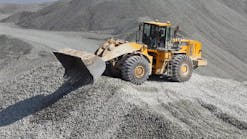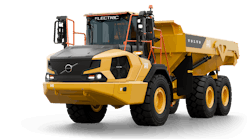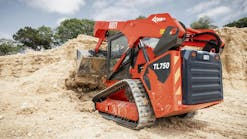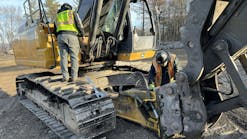When the compact tractor loader backhoe (TLB) first motored onto the scene a little more than 30 years ago, it faced an uphill climb. As with any new equipment category, it took a lot of time and exposure for the compact TLB to gain acceptance with end users. Though the DIY/homeowner and lighter-duty operators were relatively early adopters of this technology, the professional contractor crowd mostly held a skeptical view of this newcomer, deeming it as a "not-so-serious" piece of equipment — or even worse — merely a "toy."
But as time passed and more manufacturers entered the compact TLB game, the technology was pushed to new levels and a few realizations were made that started to bring more equipment operators into the fold. Though obviously lacking the power, speed and production of a full-size TLB, the ease of operation and greater maneuverability made the compact units very approachable for a wide range of operators. Additionally, the average hole/trench depth on a job site is 5 feet, which is well within the capabilities of compact TLBs. Furthermore, the smaller machines are much easier to maintain and transport than full-size units.
Altogether, these factors built a high appeal with a wide range of operators, not only with the weekend warriors, but eventually with the professional contractors as well. And soon this supposed "not-so-serious" piece of equipment became a "serious" staple in the rental industry — from small mom-and-pop stores to larger, multilocation operations primarily serving the professional contractor.
Throughout the 90s, the compact TLB experienced a boom in the rental industry. Then, in the past few years, with the advent and surging popularity of the mini-excavator and the huge marketing efforts behind skid-steer loaders, the compact TLB found itself fighting with these other equipment categories for the same rental yard space. Furthermore, some industry sources have suggested that the mini-excavator, skid-steer loader and compact TLB are interchangeable.
In actuality, though all three equipment categories are in the business of moving dirt, this question of competition is essentially a moot point since each product excels in different applications and answers different contractor demands. Yet, the apparent similarity of these products has caused some confusion in the market, with a few rental operators feeling the need to favor one category of equipment over the other. However, this is not an issue for Don Zajick, president of Norris Sales Company, Inc. For him, each of these equipment categories has earned a deserved spot in the rental industry — especially the compact TLB.
With two full-service locations, the flagship in Plymouth Meeting, PA, and the relatively new operation in Sicklerville, NJ, Norris Sales specializes in light to heavy construction equipment. Established in 1956, Norris Sales' founding philosophy is paramount to its 50 years of success — provide the best service possible. This, of course, relates to fast reaction times to equipment breakdowns and building strong relationships with customers, but it also has a lot to do with the company's commitment to offering a wide range of new equipment.
"We're successful because our customers love the way we do business," said Zajick. "We average anywhere between four and 10 new accounts per week. Currently, we have an active base of more than 1,800 customers — and our overall customer base is 12,000. One reason for this success is when it comes to equipment, our customers have every choice from us."
In regards to earth moving equipment, Norris Sales' "every choice" includes mini-excavators, skid-steer loaders and both compact and standard TLBs.
"I always try to put myself in the customer's place when we look at equipment," said Zajick.
"The truth of the matter is that every customer is different. Though mini-excavators, skid steers and compact TLBs are intended for similar applications, a one-piece-of-equipment-fits-all mentality is not going to serve our customers. There's really a need for all three pieces."
A good analogy to consider is compaction equipment. There is a wide variety of available equipment, ranging from small tampers and plate compactors to walk-behind and ride-on rollers, and so on. Though most of these are essentially intended to address the same function — compact dirt — rental operators interested in addressing the compaction needs of their customers would be remiss in only offering one or two different pieces of equipment. In fact, their compaction "fleet" would be downright inadequate. Well, the same goes for earth engaging equipment.
"Some may consider the mini-excavator, skid steer and compact TLB to be interchangeable pieces of equipment, but in fact, they're really three completely different animals," said Zajick. "There are pros and cons with each."
By its design, the compact TLB is intended to achieve 80 percent of what a skid steer and mini-excavator can do. Where it fails to reach the extra 20 percent is with the deep digging capability of the mini-excavator and the maneuverability and attachment capabilities of the skid steer.
"One of the pros of the compact TLB is you have some of the same capabilities of the mini-excavator and skid steer, but with one machine — so there's less customer investment," said Zajick. "In fact, what we've found is that when compared with larger backhoes and how customers typically use them on the job site, the compact TLB can do 75 to 90 percent of the same work, but again, at about half the rental cost."
"The pros of the skid steer are that it's much more maneuverable than a compact TLB and has many available attachment options for increased capabilities," said Zajick. "Not only is this because the skid steer can turn 360 degrees on its own axis, but bear in mind that a small TLB will be about one-and-a-half times the length of a skid steer. So it might take a minute or two to turn a compact TLB around on a tight job site, whereas it would take a matter of seconds with a skid steer. It's a productivity factor — and depending on the customer's needs, it may make all the difference."
Though the skid steer has a leg up on both the compact TLB and mini-excavator when it comes to attachment capabilities, this is not the case when one needs to dig. "Digging with a skid steer is one of the most awkward things a person can do," said Zajick. "It can take up to 30 minutes to put a backhoe on a skid steer and even then it's not very productive. On the other hand, both the mini-excavator and compact TLB are much better solutions for this type of work. Additionally, a skid steer can only use one attachment at a time, whereas the compact TLB will always have that backhoe and loader bucket readily available."
"Otherwise, the pros of a mini-excavator are that it's also much more maneuverable than a compact TLB and is more of a serious digging machine than either alternative," said Zajick. "Furthermore, it's ideal for residential applications because it's on tracks and offers very low ground pressure, meaning it won't do a lot of damage to turf. But the drawbacks of a mini-excavator are it's obviously not going to have the travel speed and loader capabilities of the compact TLB or skid steer."
Therefore, when it comes to capabilities, it's simply a trade-off. Depending on the wants and needs of the end user, any one of these pieces of equipment can be the best choice.
But in the rental business, it's not all about having an endless variety of equipment available. One has to make a living as well. For Norris Sales, the experienced return on investment has been exceptional for all three categories of equipment.
"Our average return on investment has been impressive," said Zajick. "With the compact TLBs, we average a return on investment of about 55 to 60 percent annually. It's roughly the same with mini excavators — about 60 to 65 percent. And with skid steers, we see anywhere from 75 to 90 percent return on investment. So as far as a particular piece of equipment losing its demand, we're definitely not seeing it — and the numbers are proof of that."
Of course, these numbers could be misleading if an operation only had one or two pieces of equipment in a particular category, but that's definitely not the case with Norris Sales' offering of compact TLBs. Currently, the company offers 42 Allmand compact TLBs, which is veritably unheard of in the industry. And it's a further testament to this equipment's place in the rental market.
"This category of equipment is definitely not leveling off," said Zajick. "Our compact TLB business increases year-by-year. And no matter how many new units we add, there always seems to be a demand for them."




